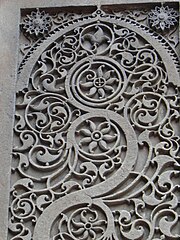See all Things to do in Ahmedabad
Sidi Saiyed Jaali
About
The Sidi Saiyyed Mosque, built in 1573, is one of the most famous mosques of Ahmedabad. As per the marble stone tablet fixed on the wall of the mosque, it was built by Sidi Saeed (aka Sidi Saiyyed) an Abyssinian in the retinue of Bilal Jhajar Khan, General in the army of the last Sultan Shams-ud-Din Muzaffar Shah III of Gujarat Sultanate The mosque was built in the last year of the Sultanate of Gujrat. The mosque is entirely arcuated and is famous for beautifully carved ten stone latticework windows (jalis) on the side and rear arches. The rear wall is filled with square stone pierced panels in geometrical designs. The two bays flanking the central aisle have reticulated stone slabs carved in designs of intertwined trees and foliage and a palm motif. This intricately carved stone window is called the Siddi Sayyed Jali. Siddi Sayyed Jali is unofficial symbol of city of Ahmedabad. It is a fine example of Indo-Saracenic architecture. This jali inspired the design of the logo of the Indian Institute of Management Ahmedabad. The mosque was pillaged by the British and they extracted the central jali and took it to the London Museum for display. [citation needed] It is also reported that a full size model of the Sidi Saiyyed Jali is on display in the UN headquarters.




